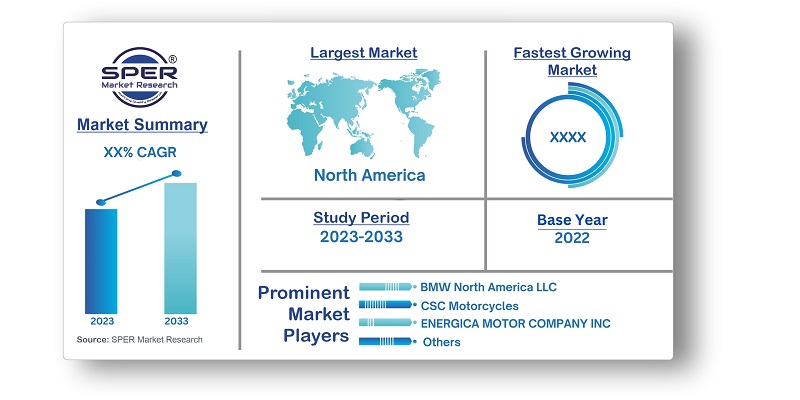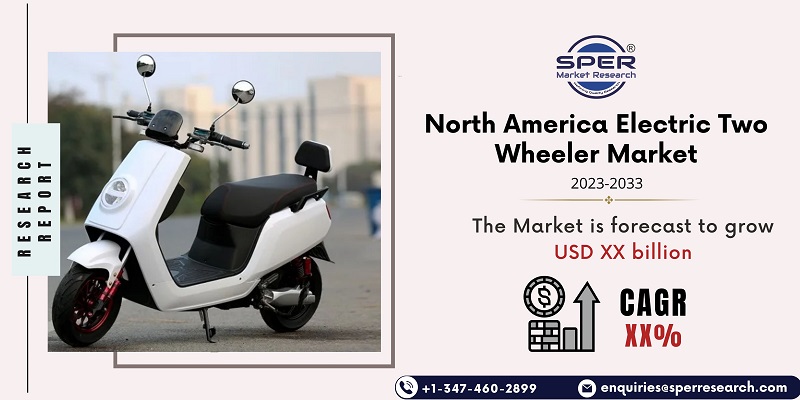
North America Electric Two Wheeler Market Growth, Trends, Size, Challenges and Future Outlook
North America Electric Two Wheeler Market Size- By Vehicle Type, By Battery Type, By Battery Capacity, By Range - Regional Outlook, Competitive Strategies and Segment Forecast to 2033
| Published: Feb-2024 | Report ID: AMIN2457 | Pages: 1 - 150 | Formats*: |
| Category : Automotive & Transportation | |||


| Report Metric | Details |
| Market size available for years | 2020-2033 |
| Base year considered | 2023 |
| Forecast period | 2024-2033 |
| Segments covered | By Vehicle Type, By Battery Type, By Battery Capacity, By Range |
| Regions covered | Canada, Mexico, United States |
| Companies Covered | BMW North America LLC, CSC Motorcycles, ENERGICA MOTOR COMPANY INC., Harley Davidson Inc., Lightning Motorcycle Corp., Niu International, Torrot Electric Europe S.A., Yamaha Motor Co. Ltd., Yadea Group Holdings Ltd., Zero Motorcycles Inc., Others |
- Urban Commuters
- Eco-Conscious Consumers
- Fitness Enthusiasts
- Senior Citizens
- Students and Campus Commuters
- Adventure Seekers
- Delivery and Logistics Industry
- Tourism and Rental Service
- Others
| By Vehicle Type: |
|
| By Battery Type: |
|
| By Battery Capacity: |
|
| By Range: |
|
- North America Electric Two Wheeler Market Size (FY’2024-FY’2033)
- Overview of North America Electric Two Wheeler Market
- Segmentation of North America Electric Two Wheeler Market By Vehicle Type (Motorcycle, Scooter/Moped)
- Segmentation of North America Electric Two Wheeler Market By Battery Type (Lead Acid, Li-ion)
- Segmentation of North America Electric Two Wheeler Market By Battery Capacity (25Ah, >25Ah)
- Segmentation of North America Electric Two Wheeler Market By Range (Less than 100 Km, 100 Km -150 km, Above 150 Km)
- Statistical Snap of North America Electric Two Wheeler Market
- Expansion Analysis of North America Electric Two Wheeler Market
- Problems and Obstacles in North America Electric Two Wheeler Market
- Competitive Landscape in the North America Electric Two Wheeler Market
- Impact of COVID-19 and Demonetization on North America Electric Two Wheeler Market
- Details on Current Investment in North America Electric Two Wheeler Market
- Competitive Analysis of North America Electric Two Wheeler Market
- Prominent Players in the North America Electric Two Wheeler Market
- SWOT Analysis of North America Electric Two Wheeler Market
- North America Electric Two Wheeler Market Future Outlook and Projections (FY’2024-FY’2033)
- Recommendations from Analyst
1.1. Scope of the report1.2. Market segment analysis
2.1. Research data source2.1.1. Secondary Data2.1.2. Primary Data2.1.3. SPER’s internal database2.1.4. Premium insight from KOL’s2.2. Market size estimation2.2.1. Top-down and Bottom-up approach2.3. Data triangulation
4.1. Driver, Restraint, Opportunity and Challenges analysis4.1.1. Drivers4.1.2. Restraints4.1.3. Opportunities4.1.4. Challenges4.2. COVID-19 Impacts of the North America Electric Two Wheeler Market
5.1. SWOT Analysis5.1.1. Strengths5.1.2. Weaknesses5.1.3. Opportunities5.1.4. Threats5.2. PESTEL Analysis5.2.1. Political Landscape5.2.2. Economic Landscape5.2.3. Social Landscape5.2.4. Technological Landscape5.2.5. Environmental Landscape5.2.6. Legal Landscape5.3. PORTER’s Five Forces5.3.1. Bargaining power of suppliers5.3.2. Bargaining power of buyers5.3.3. Threat of Substitute5.3.4. Threat of new entrant5.3.5. Competitive rivalry5.4. Heat Map Analysis
6.1. North America Electric Two Wheeler Market Manufacturing Base Distribution, Sales Area, Product Type6.2. Mergers & Acquisitions, Partnerships, Product Launch, and Collaboration in North America Electric Two Wheeler Market
7.1. North America Electric Two Wheeler Market Value Share and Forecast, By Vehicle Type, 2024-20337.2. Motorcycle7.3. Scooter/Moped
8.1. North America Electric Two Wheeler Market Value Share and Forecast, By Battery Type, 2024-20338.2. Lead Acid8.3. Li-ion
9.1. North America Electric Two Wheeler Market Value Share and Forecast, By Battery Capacity, 2024-20339.2. 25Ah9.3. >25Ah
10.1. North America Electric Two Wheeler Market Value Share and Forecast, By Range, 2024-203310.2. Less than 100 Km10.3. 100 Km -150 km10.4. Above 150 Km
11.1. North America Electric Two Wheeler Market Size and Market Share
12.1. North America Electric Two Wheeler Market Size and Market Share By Vehicle Type (2020-2026)12.2. North America Electric Two Wheeler Market Size and Market Share By Vehicle Type (2027-2033)
13.1. North America Electric Two Wheeler Market Size and Market Share By Battery Type (2020-2026)13.2. North America Electric Two Wheeler Market Size and Market Share By Battery Type (2027-2033)
14.1. North America Electric Two Wheeler Market Size and Market Share By Battery Capacity (2020-2026)14.2. North America Electric Two Wheeler Market Size and Market Share By Battery Capacity (2027-2033)
15.1. North America Electric Two Wheeler Market Size and Market Share By Range (2020-2026)15.2. North America Electric Two Wheeler Market Size and Market Share By Range (2027-2033)
16.1. North America Electric Two Wheeler Market Size and Market Share By Region (2020-2026)16.2. North America Electric Two Wheeler Market Size and Market Share By Region (2027-2033)16.3. Canada16.4. Mexico16.5. United States
17.1. BMW North America LLC17.1.1. Company details17.1.2. Financial outlook17.1.3. Product summary17.1.4. Recent developments17.2. CSC Motorcycles17.2.1. Company details17.2.2. Financial outlook17.2.3. Product summary17.2.4. Recent developments17.3. ENERGICA MOTOR COMPANY INC.17.3.1. Company details17.3.2. Financial outlook17.3.3. Product summary17.3.4. Recent developments17.4. Harley Davidson Inc.17.4.1. Company details17.4.2. Financial outlook17.4.3. Product summary17.4.4. Recent developments17.5. Lightning Motorcycle Corp.17.5.1. Company details17.5.2. Financial outlook17.5.3. Product summary17.5.4. Recent developments17.6. Niu International17.6.1. Company details17.6.2. Financial outlook17.6.3. Product summary17.6.4. Recent developments17.7. Torrot Electric Europe S.A. (Volcon ePowersports)17.7.1. Company details17.7.2. Financial outlook17.7.3. Product summary17.8. Recent developments17.9. Yadea Group Holdings Ltd.17.9.1. Company details17.9.2. Financial outlook17.9.3. Product summary17.9.4. Recent developments17.10. Yamaha Motor Co. Ltd.17.10.1. Company details17.10.2. Financial outlook17.10.3. Product summary17.10.4. Recent developments17.11. Zero Motorcycles Inc17.11.1. Company details17.11.2. Financial outlook17.11.3. Product summary17.11.4. Recent developments17.12. Others
SPER Market Research’s methodology uses great emphasis on primary research to ensure that the market intelligence insights are up to date, reliable and accurate. Primary interviews are done with players involved in each phase of a supply chain to analyze the market forecasting. The secondary research method is used to help you fully understand how the future markets and the spending patterns look likes.
The report is based on in-depth qualitative and quantitative analysis of the Product Market. The quantitative analysis involves the application of various projection and sampling techniques. The qualitative analysis involves primary interviews, surveys, and vendor briefings. The data gathered as a result of these processes are validated through experts opinion. Our research methodology entails an ideal mixture of primary and secondary initiatives.



Frequently Asked Questions About This Report
PLACE AN ORDER
Year End Discount
Sample Report
Pre-Purchase Inquiry
NEED CUSTOMIZATION?
Request CustomizationCALL OR EMAIL US
100% Secure Payment






Related Reports
Our Global Clients
Our data-driven insights have influenced the strategy of 200+ reputed companies across the globe.




















